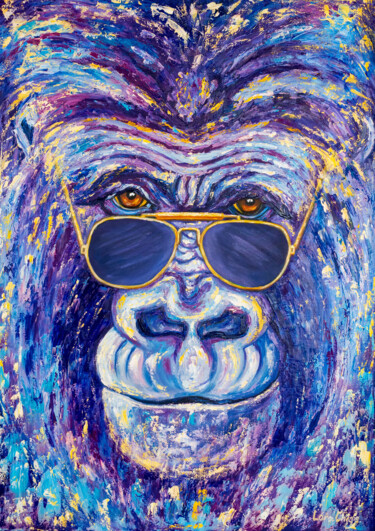 Alexandre Granger, Bad monkey, 2020. Pastel / pencil on paper, 50 x 40 cm.
Alexandre Granger, Bad monkey, 2020. Pastel / pencil on paper, 50 x 40 cm.
Why have monkeys always been a popular subject in art history?
It is widely found that monkeys have been, from the earliest times, very popular subjects in the history of art, a discipline within which they have taken on multiple meanings. This great figurative interest nurtured by man in the most varied types of primates alludes, most likely, to the fact that from the earliest days of civilization the great contiguous familiarity between these animals and Homo sapiens had been sensed. In fact, apes, often understood as amusing as well as disturbing mirrors of humanity, have often been symbolic of the primitive human being, who, lacking consciousness and culture, was literally incapable of handling the most instinctive drives.
 Frédéric Durieu & Nathalie Erin, Chimpanzee out of woods 1, 2021. 2D digital artwork on aluminum, 80 x 80 cm.
Frédéric Durieu & Nathalie Erin, Chimpanzee out of woods 1, 2021. 2D digital artwork on aluminum, 80 x 80 cm.
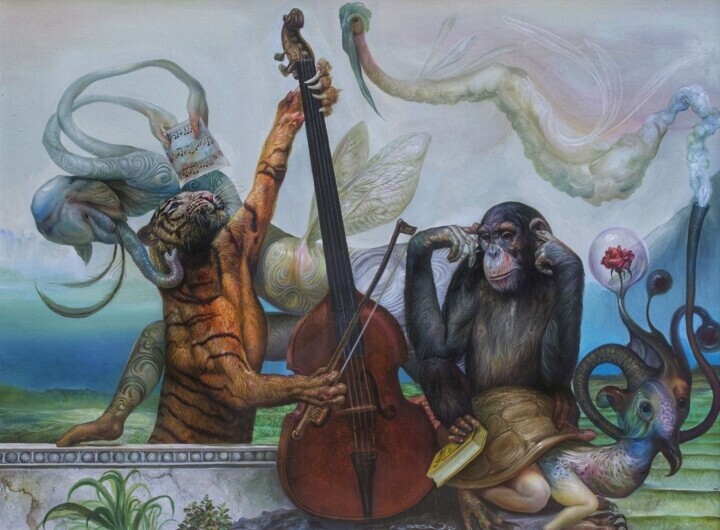 Reydel Espinosa Fernandez, Lullaby for the monkey, 2022. Oil on canvas, 68 x 91 cm.
Reydel Espinosa Fernandez, Lullaby for the monkey, 2022. Oil on canvas, 68 x 91 cm.
Monkeys in art
Among the earliest depictions of monkeys in art we certainly find Babi: fierce, virile and bloodthirsty baboon deity of ancient Egypt, oftentimes immortalized in paintings, sculptures and low reliefs. This animal had great success within the aforementioned civilization, since, probably as early as the Predynastic Period, it was considered to be the soul of the ancestors, precisely because of the affinities that the arboreal animal presented with human beings. Consequently, we owe to this purely funerary characterization of the baboon its veneration as an otherworldly deity. As for the Middle Ages, in this period the monkey began to be perceived as a vicious caricature of man, so much so that it even came to personify a kind of stand-in for the devil, characterized by highly sinful peculiarities, including, above all, malignity, lust, gluttony, idolatry, falsehood and dishonesty. In fact, the Christian iconography of the Virgin and Child of the time also began to accommodate the figure of the primate, which, placed at the feet of the Madonna, stood for the submission of falsehood before the power of the deities. An example of the above is Albrecht Dürer's iconic Virgin with Child and Monkey (c. 1498), an engraving rich in further symbolic meanings, in which the strong impact that Italian figurative culture had on the German master, a veteran of his first trip to the Bel Paese, is evident. In addition, another work aimed at underscoring the negative conception, which the said animal had in medieval times, is Pieter Bruegel the Elder's The Two Monkeys (1562), a painting in which the Dutch master immortalizes two arboreal animals chained on a window sill, accompanied by nut shells. Precisely, the two imprisoned monkeys would have lost their freedom in exchange for their favorite food, succumbing to a superfluous momentary joy, intended to allude to the most vicious part of human nature, inextricably enslaved to sin and earthly pleasures.
 Albrecht Dürer, Virgin with Child and Monkey, 1498 ca. Burin engraving.
Albrecht Dürer, Virgin with Child and Monkey, 1498 ca. Burin engraving.
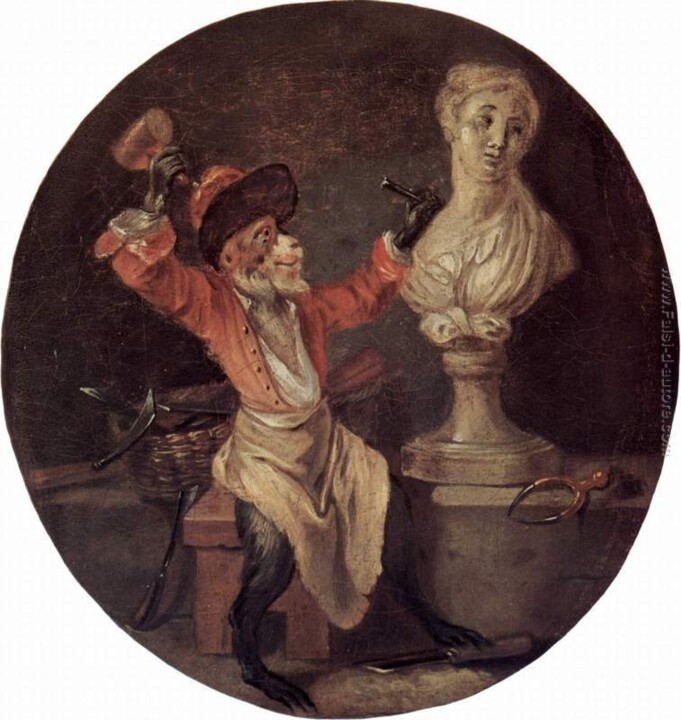 Antoine Watteau, The monkey Sculptor, 1710 circa. Oil on canvas, 22 x 21 cm. Orleans: Orleans Museum of Fine Arts.
Antoine Watteau, The monkey Sculptor, 1710 circa. Oil on canvas, 22 x 21 cm. Orleans: Orleans Museum of Fine Arts.
Subsequently, while in the 16th century mokeys continued to be symbols of sinfulness, proximity to the devil and lust, by the end of the century they also appeared in works aimed at depicting high social status, through the simple depiction of rich and sumptuous environments in which it was possible to enjoy the presence of these cute and curious exotic animals. Example of the above is Arrigo Peloso, Pietro Matto and Amon Nano (1598-1600) triple portrait by Agostino Carracci, aimed at immortalizing the eccentric entertainers of the luxurious court of Cardinal Odoardo Farnese in Rome. During the seventeenth and eighteenth centuries, on the other hand, more attention was paid to the funny resemblance between man and monkey, as well as the latter's ability to imitate the attitudes of Homo sapiens, so that there are many works of the period aimed at humanizing arboreal animals, just as can be seen in Antoine Watteau's painting, entitled The monkey Sculptor, (c. 1710) and Abraham Teniers', Barbershop with monkeys and cats (1633-1667). It is good to add how, such comic-grotesque type of artistic investigation often also alluded to a predominantly moralistic intent, aimed at judging human behavior from an objective perspective, and especially through estrangement. This viewpoint is even taken to extremes in Francisco Goya's Caprices, a series of eighty etchings, which, also depicting humanized monkeys, posed as a means of denouncing the attitudes of late 18th-century Spanish society.
 Beata Bieniak, Travels in Nihila, 2013. Analog photograph / photo manipulated on paper, 45.7 x 40.6 cm.
Beata Bieniak, Travels in Nihila, 2013. Analog photograph / photo manipulated on paper, 45.7 x 40.6 cm.
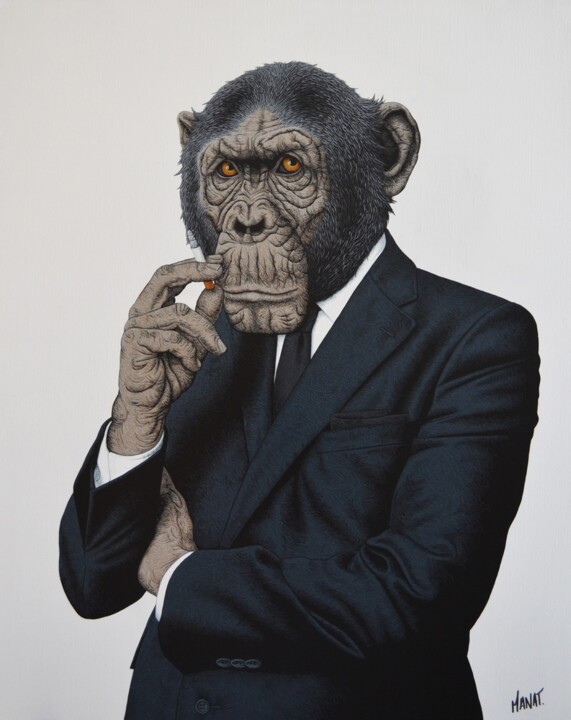 Manat, Benny buchalter, 2021. Acrylic on canvas, 81 x 65 cm.
Manat, Benny buchalter, 2021. Acrylic on canvas, 81 x 65 cm.
Monkeys: from the twentieth century to contemporary art
As far as twentieth-century and contemporary art is concerned, they are distinguished by a vast typology of depictions of the monkey, which, linked to multiple meanings, finds exemplification in some famous works of art, such as: Francis Bacon's Figure with Monkey (1951), a painting that alludes to the confrontation with the bestial reality of the human form; Frida Kahlo's multiple self-portraits with monkeys, creatures captured in all their tenderness, kindness and affection; Jeff Koons's Baloon Mokeys, mirror-polished stainless steel sculptures that, being able to reflect everything that passes on their sinuous forms, lead the viewer of the work to become more self-aware; Bansky's Devolved Parliament (2019), a painting in which monkeys become a symbol of the decay of British politics. In addition, the contemporary context is further enriched by the varied work of Artmajeur artists, just as the works of Igor Skaletsky, L'Atelier S'Affiche, and Oussama Benabbou demonstrate.
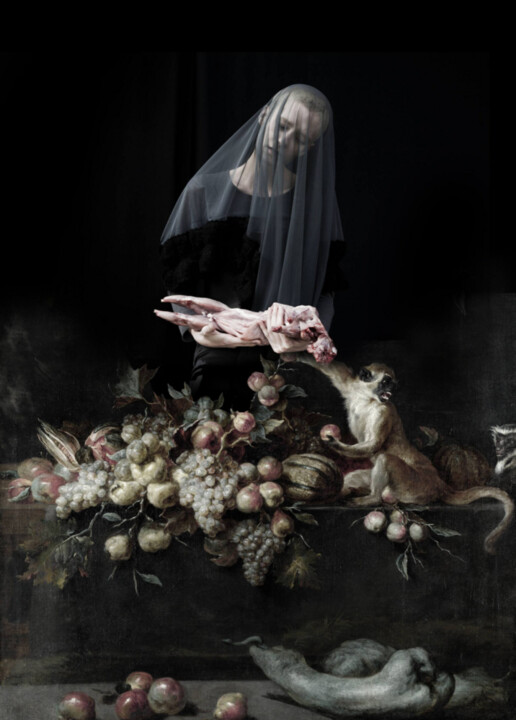 Igor Skaletsky, Still life with a monkey, 2015. Acrylic on canvas, 125 x 95 cm.
Igor Skaletsky, Still life with a monkey, 2015. Acrylic on canvas, 125 x 95 cm.
Igor Skaletsky: Still life with a monkey
Igor Skaletsky's innovative Still Life with Monkey, adds, to an extremely recurrent topic theme in art history, the presence of a mysterious veiled female figure, who, holding a probably "sacrificial" rabbit in her arms, seems almost to want to surrender it, albeit with regret, suffering and resignation, to the lustful cravings of a capuchin monkey, already intent on plundering a rich banquet, accompanied by another primate, whose figure is interrupted by the end of the canvas. The gluttony of monkeys is the recurring theme of multiple masterpieces of Western art, which by placing such primates precisely within still lifes are meant to allude to man's sins of gluttony as well as his greed, lust and gluttony. This passion for food is also often accompanied by the cunning and dishonesty of the said animal, often caught stealthily stealing from richly laid tables. Finally, bringing back some famous examples of greedy and cunning monkeys in art history, it is worth mentioning: Still Life with Monkey, Flowers and Fruit by Jean-Baptiste Monnoyer (1636-99), Still Life with Monkey, Flowers and Fruit (1724) Jean Baptiste Oudry and A Greedy Monkey (1929) by Konstantin Somov.
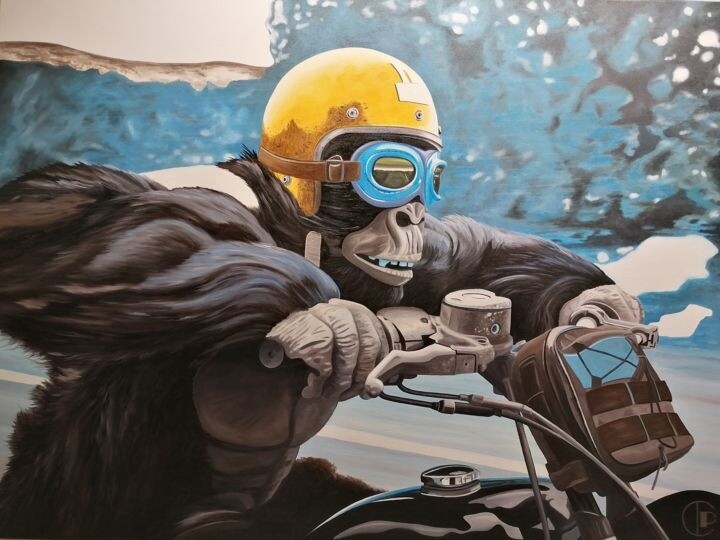 L'Atelier S'Affiche, “Monkey road”, 2020. Oil on canvas, 103 x 137 cm.
L'Atelier S'Affiche, “Monkey road”, 2020. Oil on canvas, 103 x 137 cm.
L'Atelier S'Affiche: “Monkey road”
As anticipated, monkeys, the "primitive version of Homo sapiens," have often been immortalized in attitudes worthy of the latest "upgrade" from humankind, just as the iconic artworks The Monkey Painter by David Teniers the Younger and The Monkey Antiquary (1740), as well as The Monkey Painter (1739-40) by Jean-Baptiste Chardin, demonstrate. In this context, it is worth highlighting how all these works are part of the genre of "singerie," a French term intended to allude to those visual arts in which monkeys are depicted employed in human activities, a subject that was extremely popular in early to mid-18th-century Europe. In reality, however, regarding Chardin's The Monkey Painter, the latter masterpiece does not merely humanize a monkey, as it represents a critique of the depersonalizing methodologies of the French Royal Academy of Painting and Sculpture, which, rather than having students develop critical thinking, aimed to generate sterile "monkey" imitators of artistic techniques. Speaking instead of the contemporary context, the topicality of "singerie" is well exemplified, and made extremely attal, by the painting "Monkey road", aimed at portraying a biker monkey, moving deftly through the modern chaotic urban environment.
 Oussama Benabbou, Hermes Bored Ape, 2022. Painting, spray paint / acrylic / ink on canvas, 120 x 100 cm.
Oussama Benabbou, Hermes Bored Ape, 2022. Painting, spray paint / acrylic / ink on canvas, 120 x 100 cm.
Oussama Benabbou: Hermes Bored Ape
Oussama Benabbou's painting represents an original and unique interpretation of a hugely successful contemporary subject: the Bored Ape, digital artworks having as their subject diversified types of bored monkeys, so popular on the art market that they have even attracted the attention of the well-known rapper Eminem, who purchased an NTF of them and then set the "collectibles" as the image of his Instagram profile. In fact, within the NTFs, Non Fungible Tokens, one of the very recent new technological frontiers and elitist welter of virtual artworks, stand out the very Bored Ape designed by the Bored Ape Yacht Club, a project that now boasts a nearly $100 million total turnover. Returning to the work of the Artmajeur Artist, his painting depicts a Bored Ape, which, intent on smoking a cigar, represents an obvious "testimonial" for the famous French fashion house Hermes.


 Olimpia Gaia Martinelli
Olimpia Gaia Martinelli




